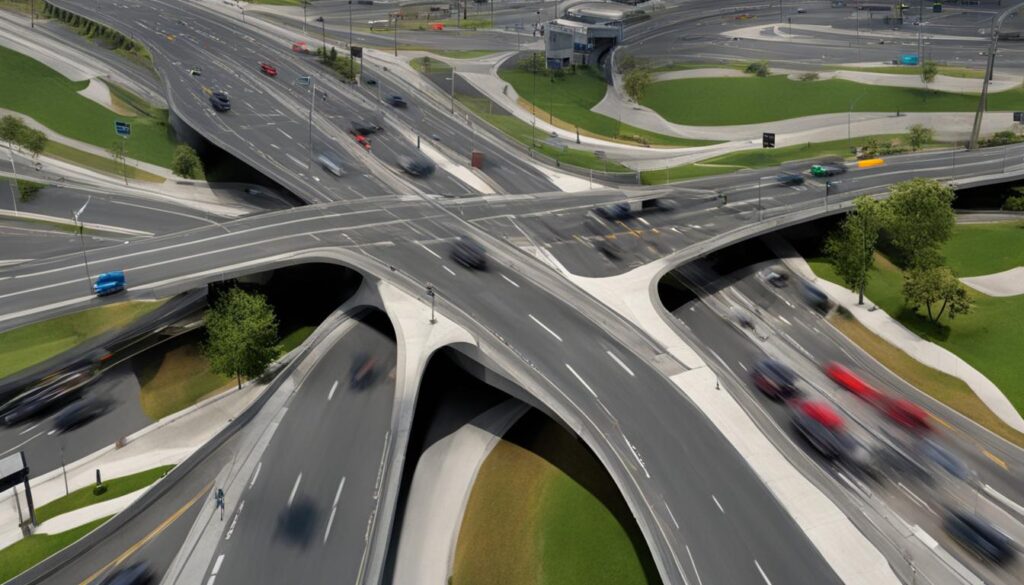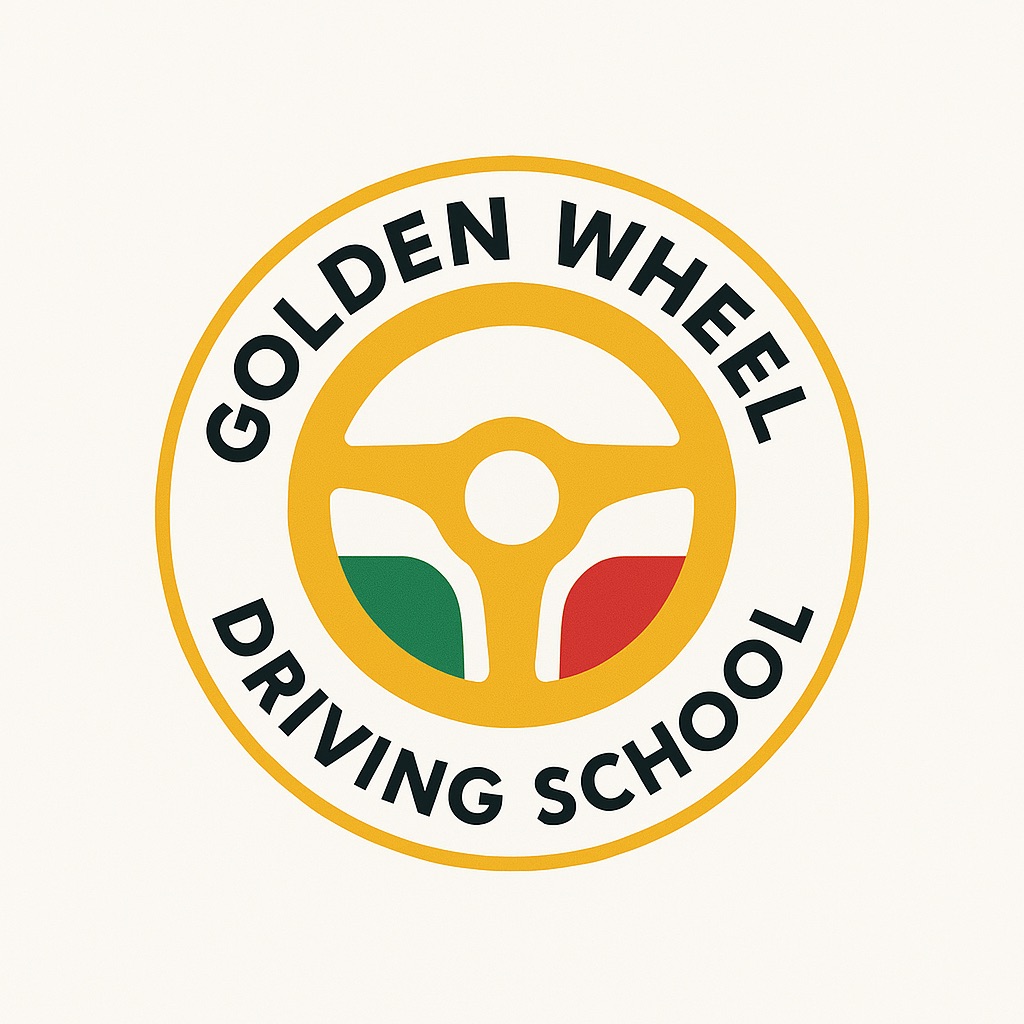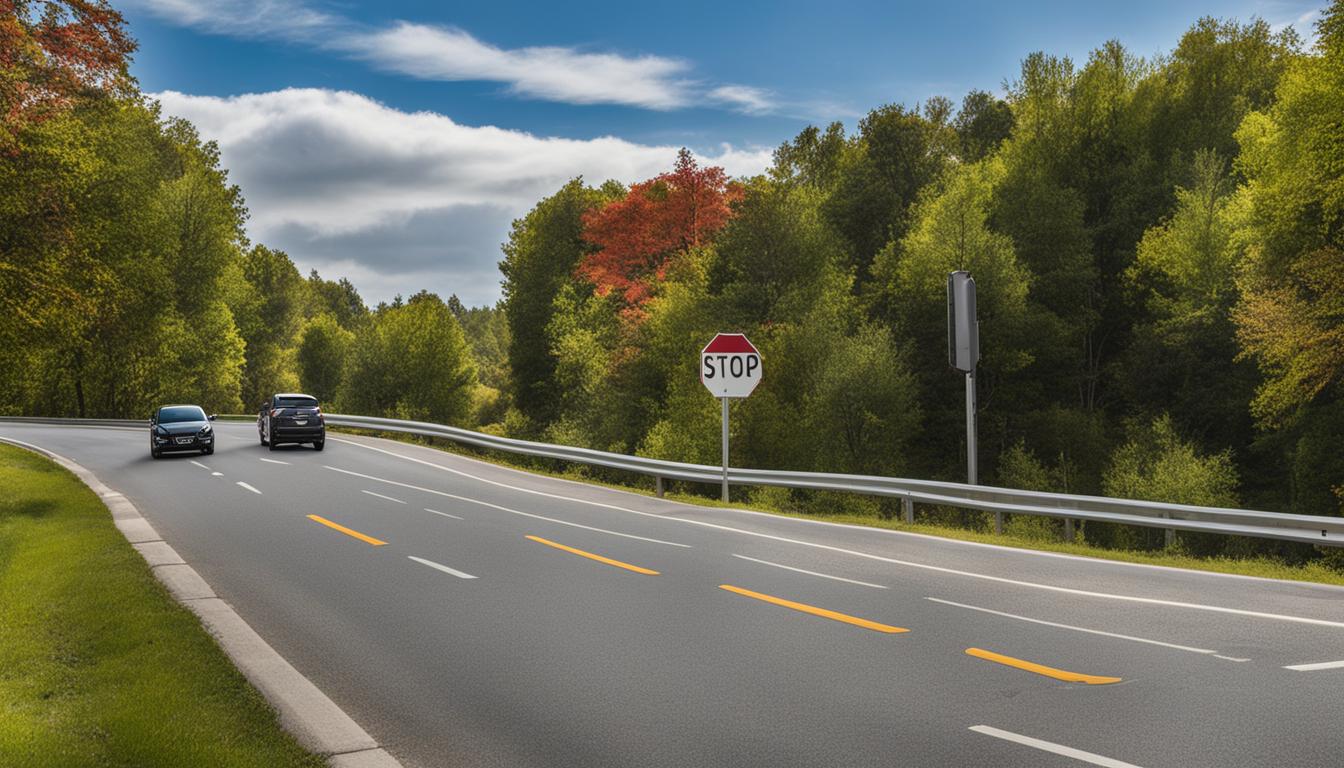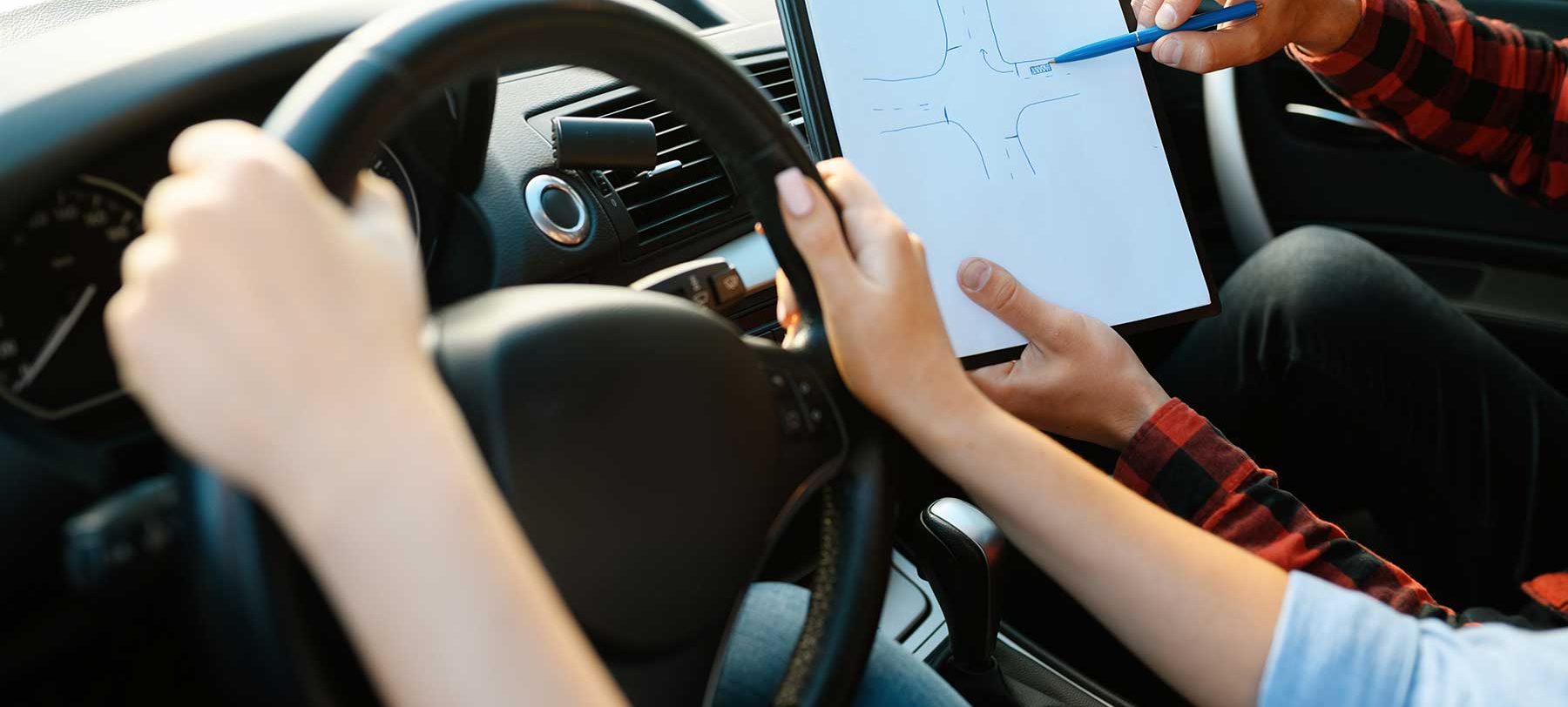As a responsible driver, it is crucial to have a thorough understanding of road rules and regulations in order to ensure safe and compliant driving on US roads. These guidelines, also known as traffic laws or driving regulations, are put in place to maintain order and minimize the risk of accidents. By familiarizing ourselves with the highway code and adhering to traffic rules, we can confidently navigate the road, protect ourselves, and contribute to a safer driving environment.
At Golden Wheel Driving School, we prioritize the importance of educating drivers on road safety regulations and providing them with the necessary driving guidelines. By equipping our students with the knowledge and skills to navigate road rules and regulations, we empower them to become responsible and competent drivers, capable of making informed decisions on the road.
Key Takeaways:
- Familiarize yourself with the road rules and regulations outlined in the highway code.
- Adhere to traffic laws to ensure safe and compliant driving.
- Understanding the right of way at intersections is essential for navigating roadways safely.
- Follow lane markings, such as solid yellow lines and solid white lines, to understand driving restrictions and rules.
- Practicing defensive driving and adhering to road etiquette promotes road safety for all.
Understanding Lane Markings and Traffic Rules
Traffic lanes are divided sections of the road that guide drivers on where to drive. Lane markings, such as solid yellow lines and solid white lines, indicate specific rules and restrictions.
For example, a solid yellow line in the center of the road with two-way traffic indicates no passing allowed. Double solid yellow lines and double solid white lines serve as barriers and should not be crossed unless in specific situations.
Broken yellow lines allow for passing when it is safe to do so. Understanding these lane markings is essential for safe and lawful driving.
Choosing the Right Lane and Changing Lanes Safely
When it comes to driving on multi-lane roads, choosing the right lane and changing lanes safely are essential skills for a confident and safe driver. Let’s explore the different types of lanes and their purposes on the road.
Numbered Traffic Lanes
Traffic lanes are often numbered, with the left lane being the Number 1 Lane. These numbered lanes help organize traffic flow and provide a clear understanding of each lane’s purpose.
The Passing Lane
The passing lane, usually located on the far left, is intended for passing slower-moving vehicles. It’s essential to use this lane responsibly and move back to the right lanes once the pass is complete. Always check your blind spots and use your turn signals when changing lanes.
HOV Lane
The HOV (High Occupancy Vehicle) lane is reserved for carpooling, buses, motorcycles, or low-emission vehicles. This lane helps reduce congestion and encourages eco-friendly commuting options. Make sure you meet the designated requirements before using the HOV lane.
Center Left Turn Lane
The center left turn lane, also known as a center turn lane or middle lane, is used for making left turns or U-turns. It helps separate turning traffic from through traffic, making these maneuvers safer and more efficient.
Bicycle Lanes
Bicycle lanes are dedicated lanes for bicycles only, promoting safe cycling and reducing conflicts between bicycles and motor vehicles. As a driver, make sure to respect the bicycle lanes and avoid using them unless necessary for specific reasons like parking or making a turn.
Understanding the purpose and rules associated with each lane type is crucial for safe and efficient driving. By following lane guidelines and making lane changes in a safe and courteous manner, we can ensure a smoother and safer traffic flow for everyone on the road.
Negotiating Right and Left Turns
Knowing the proper techniques for making right and left turns is vital for safe and efficient driving. When making a right turn, I approach the intersection correctly, yield to pedestrians and oncoming traffic, and follow the proper turning procedure. By maintaining awareness of my surroundings and using appropriate signals, I ensure a smooth and safe maneuver.
For left turns, I yield to oncoming traffic and position my vehicle in the correct lane. By carefully judging the gap and avoiding any sudden movements, I complete the turn safely. Practicing patience and awareness allows me to navigate left turns confidently while maintaining the flow of traffic.
U-turns should only be made under specific conditions and following proper procedures to avoid accidents. It is important to check for any signage or legal restrictions that may prohibit U-turns at a specific location. By observing traffic and ensuring a clear and safe opportunity, I execute U-turns smoothly and without disrupting the flow of other vehicles.
I am always mindful of the right-of-way rules while making turns. Yielding to pedestrians, cyclists, and other vehicles is my top priority, ensuring the safety of everyone on the road.
Right Turn Procedure:
- Approach the intersection in the right lane.
- Check for pedestrians and oncoming traffic.
- Signal your intention to turn right.
- Come to a complete stop, if necessary, before making the turn.
- Turn with caution, staying within your lane and maintaining a safe speed.
Left Turn Procedure:
- Approach the intersection in the appropriate lane for a left turn.
- Check for oncoming traffic and yield to vehicles already in the intersection.
- Signal your intention to turn left.
- Position your vehicle in the center of the intersection, if applicable.
- Wait for a safe gap in traffic and complete the turn smoothly.
U-Turn Procedure:
- Check for any signs or restrictions prohibiting U-turns.
- Search for a safe and legal location to execute the U-turn.
- Signal your intention to make a U-turn.
- Ensure the way is clear of oncoming traffic from both directions.
- Execute the U-turn, maintaining control and being mindful of surrounding traffic.
| Turn Type | Procedure |
|---|---|
| Right Turn | Approach intersection correctly, yield to pedestrians and oncoming traffic, follow the proper turning procedure |
| Left Turn | Yield to oncoming traffic, position the vehicle correctly, complete the turn safely |
| U-Turn | Only make under specific conditions, follow proper procedures to avoid accidents |
Parallel Parking and Parking Regulations
Parallel parking is a fundamental skill that every driver should master, particularly in urban areas where parking spaces are limited. The ability to find a suitable space, position the vehicle accurately, and be mindful of surrounding traffic is essential for smooth parallel parking maneuvers.
At Golden Wheel Driving School, we prioritize teaching parallel parking techniques to our students. Our experienced instructors guide learners through the step-by-step process, ensuring they gain the confidence and proficiency needed to park safely and efficiently.
However, it’s not just about the parking itself. Understanding parking regulations, including the significance of colored curbs, is equally vital for responsible driving. Let’s take a closer look at the specific regulations related to parking:
| Colored Curbs | Parking Restrictions |
|---|---|
| White Curb | Stopping only for a short period of time to drop off or pick up passengers is allowed. |
| Green Curb | Parking is permitted for a limited time. Be sure to check for any posted time restrictions. |
| Yellow Curb | Stopping or parking is prohibited, except for brief loading or unloading of passengers or items. |
| Red Curb | No stopping, standing, or parking at any time. This is typically reserved for fire hydrants and other emergency zones. |
| Blue Curb | Reserved for persons with disabilities who possess a valid disabled parking placard or license plate. |
Another aspect to consider is parking on hills. Parking on an incline or decline requires proper wheel positioning and the use of the parking brake to prevent the vehicle from rolling. Always be cautious when parking on hills to avoid accidents.
Stay tuned for the next section where I’ll be discussing how to navigate uncontrolled intersections and understand right of way rules.

| Right of Way Rule | Description |
|---|---|
| Vehicle on the Right | When two vehicles arrive at an uncontrolled intersection simultaneously, the vehicle on the right has the right of way and should proceed first. |
| Vehicle Already in the Intersection | If a vehicle has already entered the intersection, other vehicles should yield and allow that vehicle to clear the intersection first. |
| Vehicle Turning Left Must Yield | When a vehicle approach intersection, it should yield the right of way to any vehicle that is already in the intersection. |
| Pedestrians | It is important to yield the right of way to pedestrians crossing at an uncontrolled intersection. Pedestrian safety is paramount. |
Road Etiquette and Defensive Driving
When it comes to safe driving, road etiquette and defensive driving techniques play a crucial role in maintaining a secure environment for everyone on the road. By practicing safe driving practices, such as using turn signals, maintaining a safe following distance, and avoiding aggressive maneuvers, we can greatly reduce the risk of accidents and promote a harmonious driving experience.
Defensive driving is another essential skill that all drivers should master. By anticipating potential hazards, staying alert, and minimizing distractions, we can be proactive in avoiding dangerous situations and responding effectively to unexpected events on the road.
Additionally, maximizing fuel efficiency is not only beneficial for our wallets but also for the environment. By adopting fuel-efficient driving habits, such as avoiding excessive acceleration and maintaining a steady speed, we can reduce emissions and conserve valuable resources.
Remember, road etiquette, defensive driving, and maximizing fuel efficiency are not only individual responsibilities but also contribute to creating a safer and more sustainable driving culture for everyone.
By adopting a considerate and defensive approach to driving, we can make a positive impact on our communities, reduce accidents, and ensure a smoother and more enjoyable driving experience for all.
Interacting with Law Enforcement during Traffic Stops
Knowing how to interact with law enforcement during traffic stops is vital to ensure compliance and avoid legal issues. When a driver encounters a traffic stop, it is crucial to understand their rights and responsibilities and to follow proper protocol. Here are some important guidelines to keep in mind:
- Remain calm and stay in your vehicle: Pull over to a safe location promptly, turn off the engine, and keep your hands visible on the steering wheel. Avoid any sudden movements that may raise concerns for the officer.
- Cooperate with the officer: When the officer approaches your vehicle, provide the necessary documents promptly, such as your driver’s license, registration, and proof of insurance. Avoid reaching for items without notifying the officer first.
- Exercise your rights: You have the right to remain silent and not answer any questions beyond providing identification and vehicle-related documents. It is advisable to politely decline to answer questions that may incriminate you.
- Handling traffic citations: If the officer decides to issue a traffic citation, accept it calmly without admitting guilt. You can contest the citation in court if you believe you are not at fault. Follow the provided instructions on how to proceed with the citation.
- Maintain a respectful attitude: Treat the officer with respect and courtesy, even if you disagree with their actions or decisions. Arguing or becoming confrontational may escalate the situation.
- Understanding your rights: Familiarize yourself with your specific state’s laws and regulations regarding traffic stops and search and seizure procedures. This knowledge will help you assert your rights if necessary.
- Filing complaints: If you believe your rights were violated during a traffic stop, you have the right to file a complaint against the law enforcement agency. Consult the agency’s website or contact them directly for information on their complaint process.
“Remember, it is essential to stay calm, respectful, and aware of your rights during a traffic stop. A positive interaction can help ensure your safety, maintain compliance, and protect your legal interests.”
– Golden Wheel Driving School
| Key Points | Actions |
|---|---|
| Remain calm and stay in your vehicle | Immediately pull over to a safe location, turn off the engine, and keep your hands visible on the steering wheel. |
| Cooperate with the officer | Provide identification and necessary vehicle-related documents promptly. Avoid sudden movements that may raise concerns. |
| Exercise your rights | You have the right to remain silent and not answer any questions beyond providing identification and vehicle-related documents. |
| Handling traffic citations | Accept the citation calmly without admitting guilt. Follow the provided instructions on how to proceed. |
| Maintain a respectful attitude | Treat the officer with respect and courtesy, even if you disagree with their actions or decisions. |
| Understanding your rights | Familiarize yourself with your specific state’s laws and regulations to assert your rights if necessary. |
| Filing complaints | If your rights were violated, you have the right to file a complaint against the law enforcement agency. |
Conclusion
Navigating road rules and regulations is vital for safe and compliant driving. As a responsible driver, I understand the importance of following traffic laws, knowing right of way rules, and practicing defensive driving techniques. By adhering to these guidelines, I can ensure not only my safety but also the safety of other road users.
Staying informed about road regulations is essential for confident navigation on the streets. Whether it’s understanding lane markings, choosing the correct lane, or negotiating turns, being knowledgeable about traffic rules helps create a safer driving environment.
At Golden Wheel Driving School, we emphasize compliance with road rules and regulations to promote traffic safety. Our goal is to equip drivers like me with the necessary skills and knowledge to drive safely and responsibly. Whether it’s learning to parallel park, dealing with uncontrolled intersections, or practicing defensive driving, we prioritize road safety and compliance in all our training programs.
By upholding road rules and regulations and continuously enhancing our driving skills, we can contribute to a safer driving environment and reduce the risk of accidents. Together, let’s prioritize safe driving, adhere to traffic laws, and ensure compliance on the road. Contact Golden Wheel Driving School at 75 Broadway, Elmwood Park, NJ 07407 or call us at 201-797-5858 to start your journey towards becoming a confident and responsible driver.
FAQ
What are road rules and regulations?
Road rules and regulations are guidelines set forth by governing bodies to ensure safe and compliant driving on roads. They include traffic laws, driving regulations, and guidelines outlined in the highway code.
Why is it important to understand road rules and regulations?
Understanding road rules and regulations is crucial for safe driving. It helps drivers navigate the road confidently, minimize the risk of accidents, and maintain a safe driving environment.
What do lane markings on the road indicate?
Lane markings, such as solid yellow lines and solid white lines, indicate specific rules and restrictions. They guide drivers on where to drive and inform them about passing zones, barriers, and other important information.
How should I choose the right lane for driving?
Traffic lanes are often numbered, with the left lane being the Number 1 Lane. Drivers should choose lanes based on their intended maneuver, such as passing, turning, or entering/exiting traffic.
What are the proper techniques for making right and left turns?
When making a right turn, drivers should approach the intersection correctly, yield to pedestrians and oncoming traffic, and follow the proper turning procedure. Left turns require yielding to oncoming traffic, positioning the vehicle correctly, and completing the turn safely.
How do I parallel park properly?
Proper techniques for parallel parking include finding a suitable space, positioning the vehicle accurately, and being mindful of surrounding traffic. Understanding parking regulations and colored curbs is also crucial.
How do I navigate uncontrolled intersections?
Uncontrolled intersections are intersections without traffic control signs or signals. Drivers should use caution, yield to cross traffic, and follow right of way rules to safely navigate these intersections.
What is road etiquette and why is it important?
Road etiquette refers to following safe driving practices and being courteous to other drivers. It is important for maintaining a safe driving environment and preventing accidents. This includes using turn signals, maintaining a safe following distance, and avoiding aggressive maneuvers.
What should I know about interacting with law enforcement during traffic stops?
It is important to understand your rights, such as the right to remain silent and the right to decline certain requests. Drivers should follow instructions from law enforcement officers and maintain a respectful attitude. Knowing how to handle traffic citations and file complaints against law enforcement agencies is also valuable information.
How can I contribute to road safety and compliance?
By understanding traffic laws, following safe driving practices, and staying informed about road regulations, you can ensure your safety and the safety of others on the road. Practice defensive driving techniques, anticipate hazards, and minimize distractions to maximize road safety.







